INF80025 - Analyzing Business Problems at Clinical Healthcare Inc
VerifiedAdded on 2023/06/14
|15
|3220
|415
Report
AI Summary
This report presents a business analysis of Clinical Healthcare Inc., an intravenous immune globulin therapy provider, focusing on identifying and prioritizing key problems within the organization. The analysis highlights issues such as delays in service, complicated production processes, outdated IT systems, negligence in business applications, and a lack of business progress. The report prioritizes these problems, emphasizing the critical need for system updates and addressing service delays. It further specifies these problems, categorizing them as either 'hard' or 'soft' based on their nature and the company's ability to influence them. The report identifies key stakeholders, including internal operational staff, executive management, external nurses and physicians, and clients. It also suggests using tools and techniques like DRIVE and Force Field Analysis to improve processes and understand influencing factors. A rich picture evaluation and Blum's evaluation paper are mentioned as methodologies for further analysis. Desklib offers a variety of solved assignments and past papers for students.
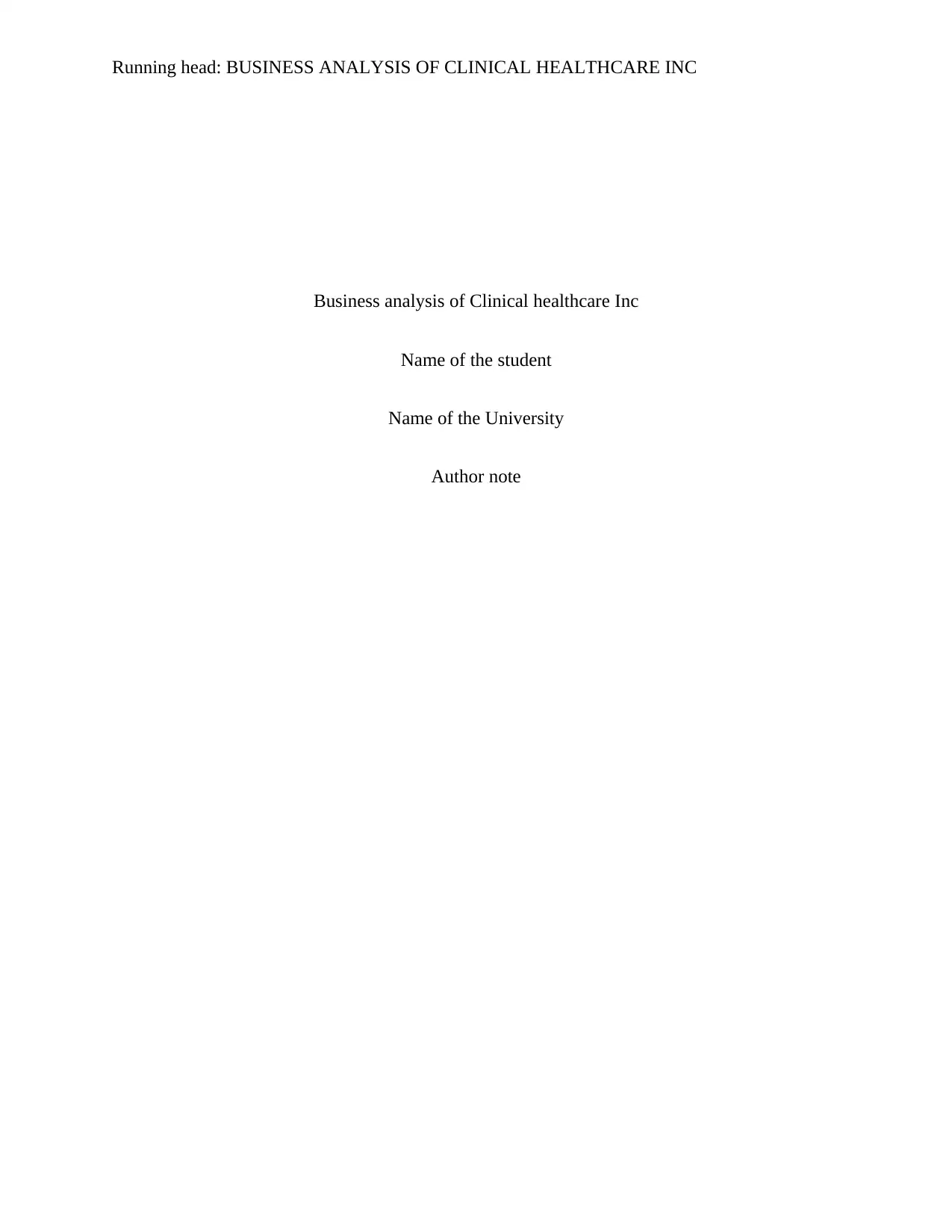
Running head: BUSINESS ANALYSIS OF CLINICAL HEALTHCARE INC
Business analysis of Clinical healthcare Inc
Name of the student
Name of the University
Author note
Business analysis of Clinical healthcare Inc
Name of the student
Name of the University
Author note
Paraphrase This Document
Need a fresh take? Get an instant paraphrase of this document with our AI Paraphraser
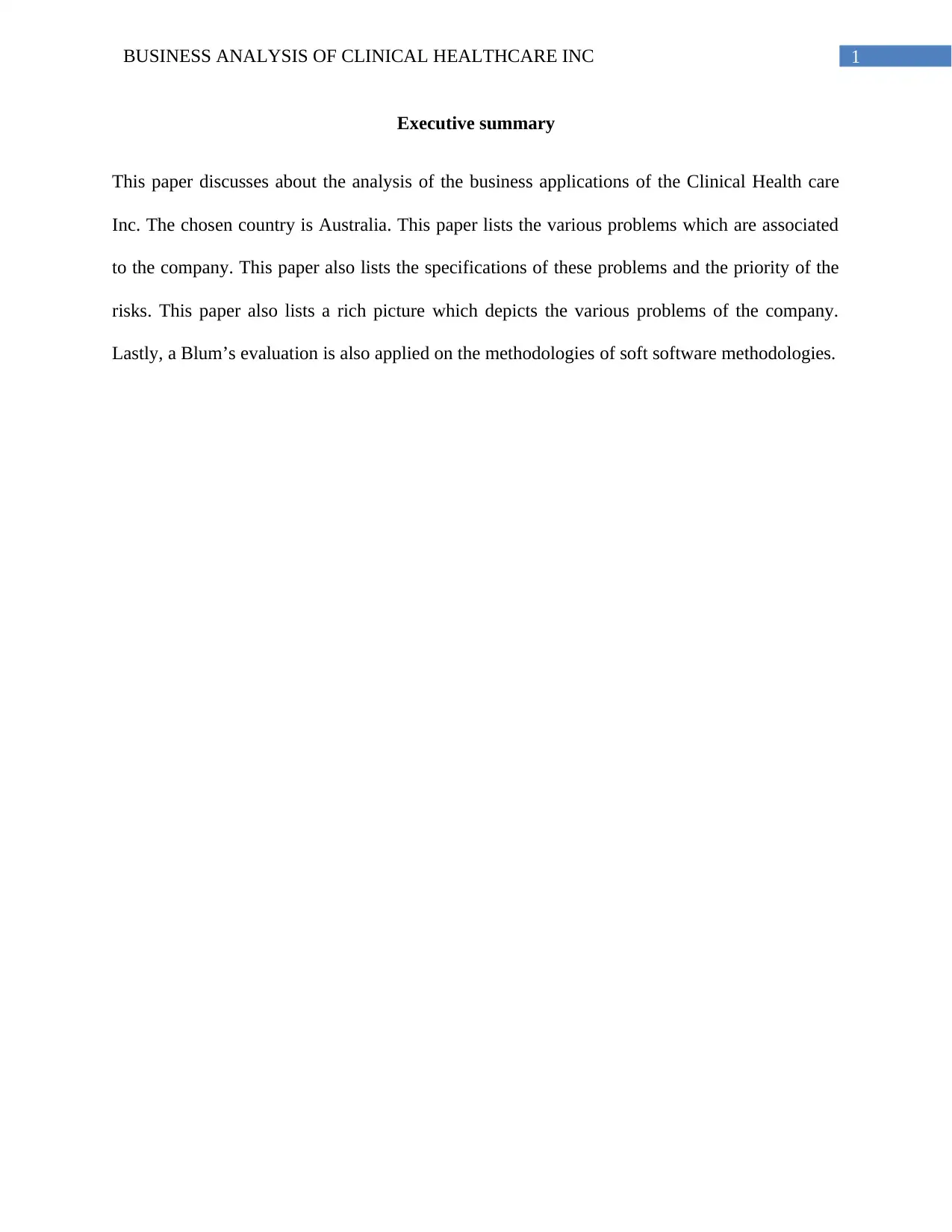
1BUSINESS ANALYSIS OF CLINICAL HEALTHCARE INC
Executive summary
This paper discusses about the analysis of the business applications of the Clinical Health care
Inc. The chosen country is Australia. This paper lists the various problems which are associated
to the company. This paper also lists the specifications of these problems and the priority of the
risks. This paper also lists a rich picture which depicts the various problems of the company.
Lastly, a Blum’s evaluation is also applied on the methodologies of soft software methodologies.
Executive summary
This paper discusses about the analysis of the business applications of the Clinical Health care
Inc. The chosen country is Australia. This paper lists the various problems which are associated
to the company. This paper also lists the specifications of these problems and the priority of the
risks. This paper also lists a rich picture which depicts the various problems of the company.
Lastly, a Blum’s evaluation is also applied on the methodologies of soft software methodologies.
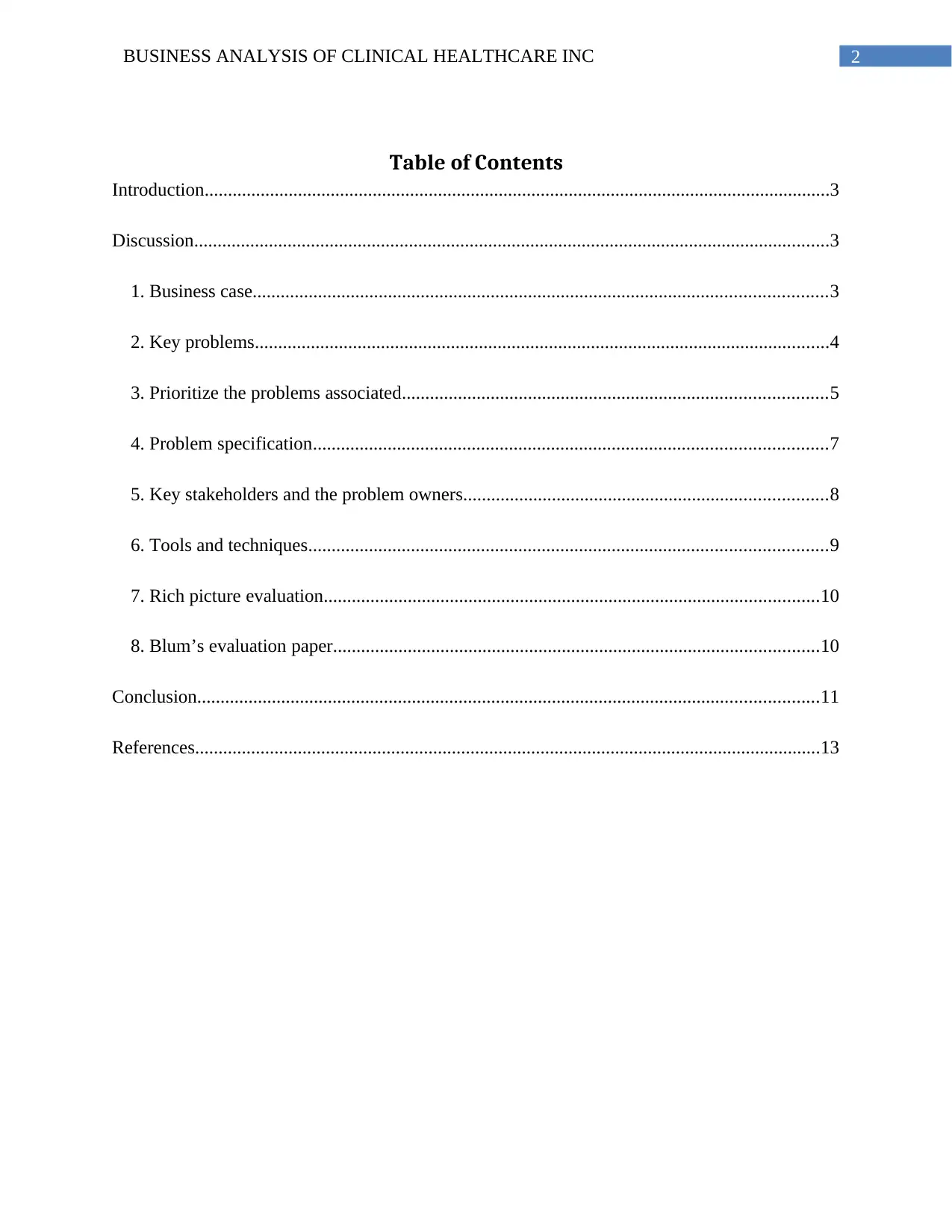
2BUSINESS ANALYSIS OF CLINICAL HEALTHCARE INC
Table of Contents
Introduction......................................................................................................................................3
Discussion........................................................................................................................................3
1. Business case...........................................................................................................................3
2. Key problems...........................................................................................................................4
3. Prioritize the problems associated...........................................................................................5
4. Problem specification..............................................................................................................7
5. Key stakeholders and the problem owners..............................................................................8
6. Tools and techniques...............................................................................................................9
7. Rich picture evaluation..........................................................................................................10
8. Blum’s evaluation paper........................................................................................................10
Conclusion.....................................................................................................................................11
References......................................................................................................................................13
Table of Contents
Introduction......................................................................................................................................3
Discussion........................................................................................................................................3
1. Business case...........................................................................................................................3
2. Key problems...........................................................................................................................4
3. Prioritize the problems associated...........................................................................................5
4. Problem specification..............................................................................................................7
5. Key stakeholders and the problem owners..............................................................................8
6. Tools and techniques...............................................................................................................9
7. Rich picture evaluation..........................................................................................................10
8. Blum’s evaluation paper........................................................................................................10
Conclusion.....................................................................................................................................11
References......................................................................................................................................13
⊘ This is a preview!⊘
Do you want full access?
Subscribe today to unlock all pages.

Trusted by 1+ million students worldwide
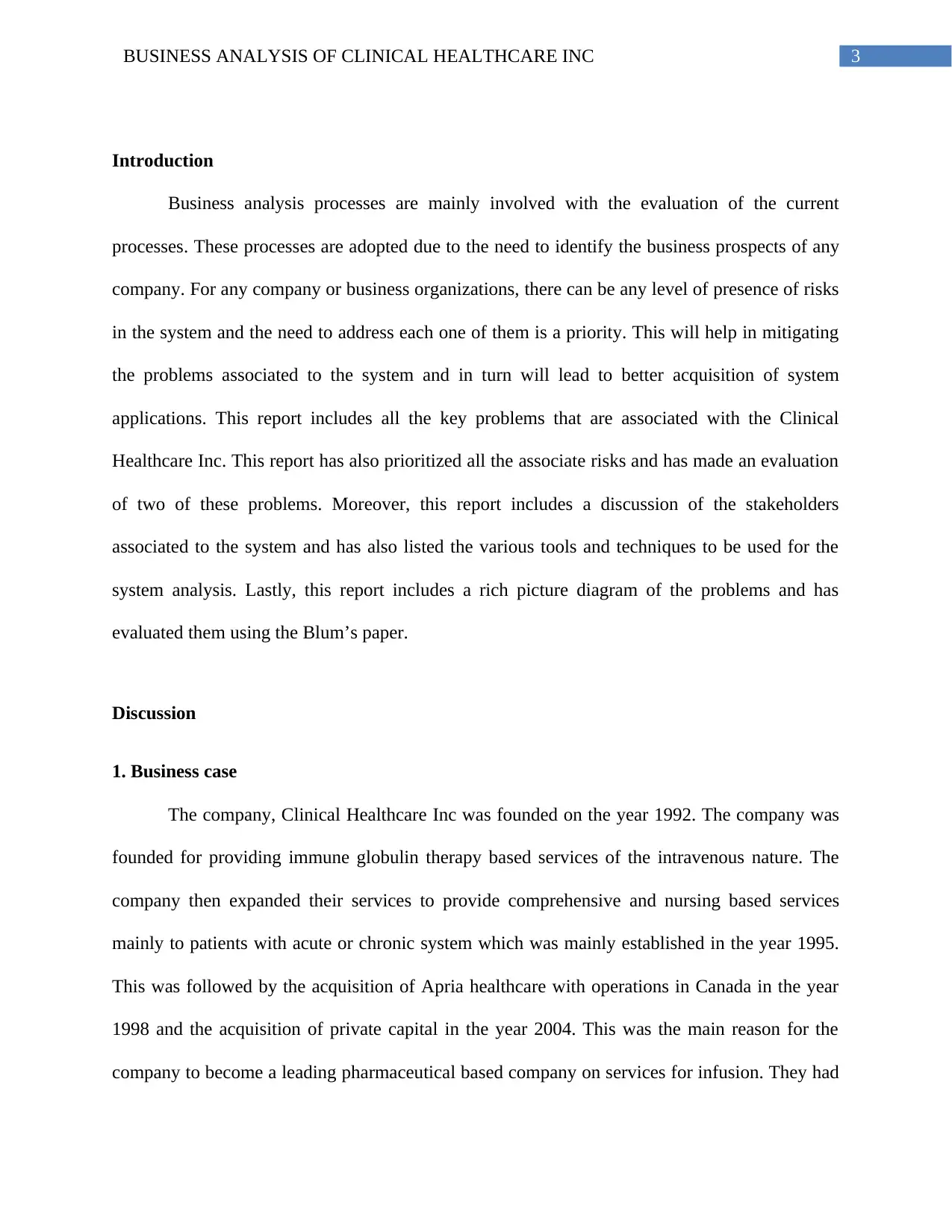
3BUSINESS ANALYSIS OF CLINICAL HEALTHCARE INC
Introduction
Business analysis processes are mainly involved with the evaluation of the current
processes. These processes are adopted due to the need to identify the business prospects of any
company. For any company or business organizations, there can be any level of presence of risks
in the system and the need to address each one of them is a priority. This will help in mitigating
the problems associated to the system and in turn will lead to better acquisition of system
applications. This report includes all the key problems that are associated with the Clinical
Healthcare Inc. This report has also prioritized all the associate risks and has made an evaluation
of two of these problems. Moreover, this report includes a discussion of the stakeholders
associated to the system and has also listed the various tools and techniques to be used for the
system analysis. Lastly, this report includes a rich picture diagram of the problems and has
evaluated them using the Blum’s paper.
Discussion
1. Business case
The company, Clinical Healthcare Inc was founded on the year 1992. The company was
founded for providing immune globulin therapy based services of the intravenous nature. The
company then expanded their services to provide comprehensive and nursing based services
mainly to patients with acute or chronic system which was mainly established in the year 1995.
This was followed by the acquisition of Apria healthcare with operations in Canada in the year
1998 and the acquisition of private capital in the year 2004. This was the main reason for the
company to become a leading pharmaceutical based company on services for infusion. They had
Introduction
Business analysis processes are mainly involved with the evaluation of the current
processes. These processes are adopted due to the need to identify the business prospects of any
company. For any company or business organizations, there can be any level of presence of risks
in the system and the need to address each one of them is a priority. This will help in mitigating
the problems associated to the system and in turn will lead to better acquisition of system
applications. This report includes all the key problems that are associated with the Clinical
Healthcare Inc. This report has also prioritized all the associate risks and has made an evaluation
of two of these problems. Moreover, this report includes a discussion of the stakeholders
associated to the system and has also listed the various tools and techniques to be used for the
system analysis. Lastly, this report includes a rich picture diagram of the problems and has
evaluated them using the Blum’s paper.
Discussion
1. Business case
The company, Clinical Healthcare Inc was founded on the year 1992. The company was
founded for providing immune globulin therapy based services of the intravenous nature. The
company then expanded their services to provide comprehensive and nursing based services
mainly to patients with acute or chronic system which was mainly established in the year 1995.
This was followed by the acquisition of Apria healthcare with operations in Canada in the year
1998 and the acquisition of private capital in the year 2004. This was the main reason for the
company to become a leading pharmaceutical based company on services for infusion. They had
Paraphrase This Document
Need a fresh take? Get an instant paraphrase of this document with our AI Paraphraser
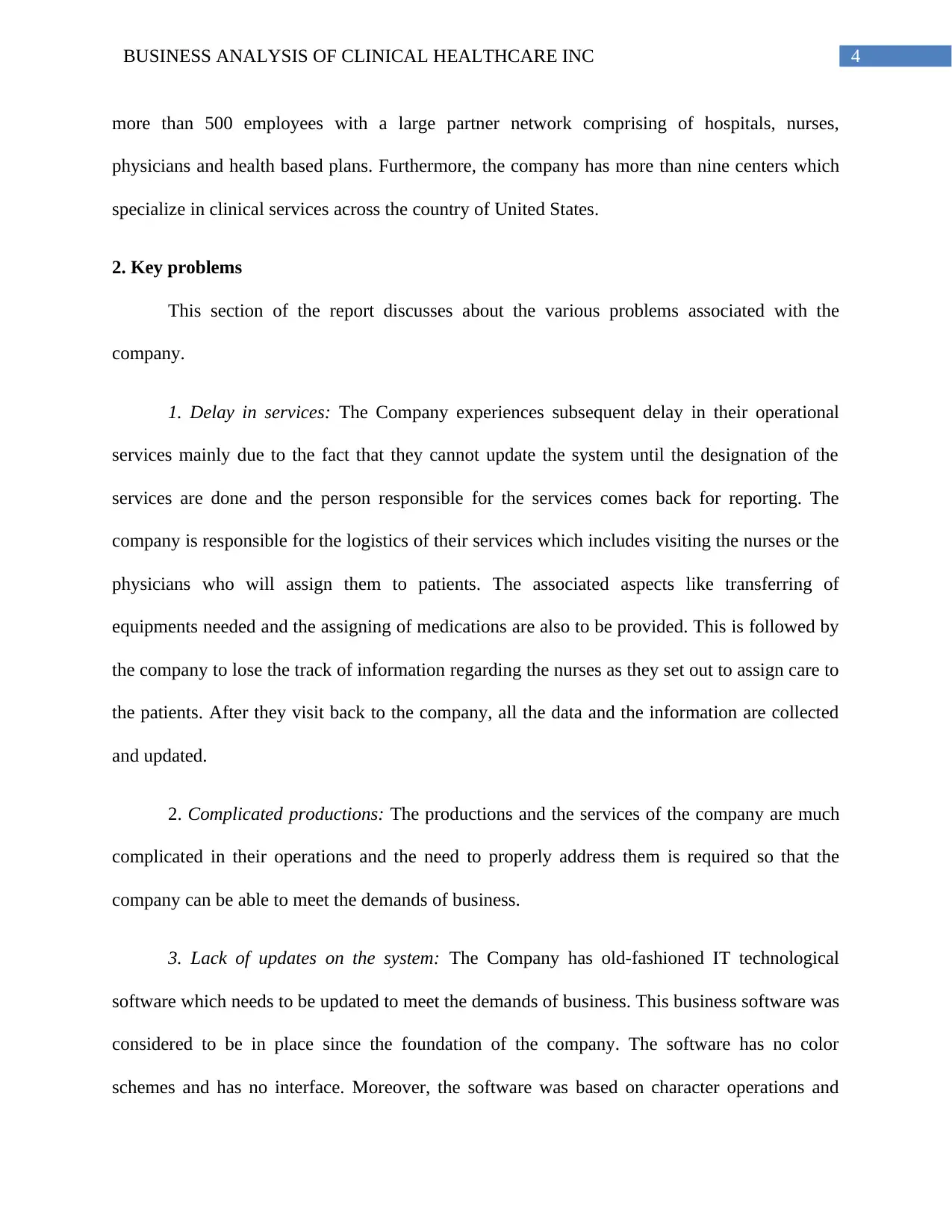
4BUSINESS ANALYSIS OF CLINICAL HEALTHCARE INC
more than 500 employees with a large partner network comprising of hospitals, nurses,
physicians and health based plans. Furthermore, the company has more than nine centers which
specialize in clinical services across the country of United States.
2. Key problems
This section of the report discusses about the various problems associated with the
company.
1. Delay in services: The Company experiences subsequent delay in their operational
services mainly due to the fact that they cannot update the system until the designation of the
services are done and the person responsible for the services comes back for reporting. The
company is responsible for the logistics of their services which includes visiting the nurses or the
physicians who will assign them to patients. The associated aspects like transferring of
equipments needed and the assigning of medications are also to be provided. This is followed by
the company to lose the track of information regarding the nurses as they set out to assign care to
the patients. After they visit back to the company, all the data and the information are collected
and updated.
2. Complicated productions: The productions and the services of the company are much
complicated in their operations and the need to properly address them is required so that the
company can be able to meet the demands of business.
3. Lack of updates on the system: The Company has old-fashioned IT technological
software which needs to be updated to meet the demands of business. This business software was
considered to be in place since the foundation of the company. The software has no color
schemes and has no interface. Moreover, the software was based on character operations and
more than 500 employees with a large partner network comprising of hospitals, nurses,
physicians and health based plans. Furthermore, the company has more than nine centers which
specialize in clinical services across the country of United States.
2. Key problems
This section of the report discusses about the various problems associated with the
company.
1. Delay in services: The Company experiences subsequent delay in their operational
services mainly due to the fact that they cannot update the system until the designation of the
services are done and the person responsible for the services comes back for reporting. The
company is responsible for the logistics of their services which includes visiting the nurses or the
physicians who will assign them to patients. The associated aspects like transferring of
equipments needed and the assigning of medications are also to be provided. This is followed by
the company to lose the track of information regarding the nurses as they set out to assign care to
the patients. After they visit back to the company, all the data and the information are collected
and updated.
2. Complicated productions: The productions and the services of the company are much
complicated in their operations and the need to properly address them is required so that the
company can be able to meet the demands of business.
3. Lack of updates on the system: The Company has old-fashioned IT technological
software which needs to be updated to meet the demands of business. This business software was
considered to be in place since the foundation of the company. The software has no color
schemes and has no interface. Moreover, the software was based on character operations and
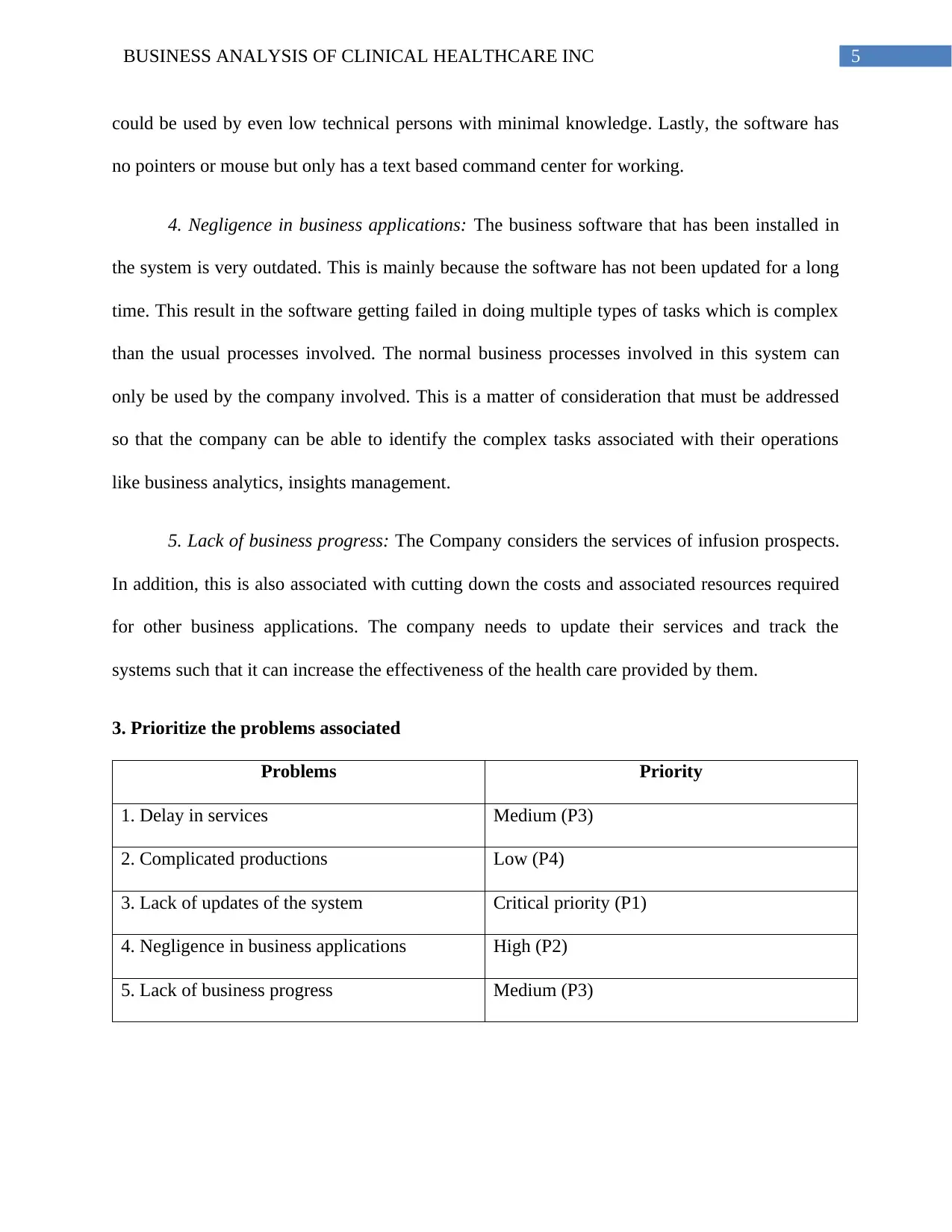
5BUSINESS ANALYSIS OF CLINICAL HEALTHCARE INC
could be used by even low technical persons with minimal knowledge. Lastly, the software has
no pointers or mouse but only has a text based command center for working.
4. Negligence in business applications: The business software that has been installed in
the system is very outdated. This is mainly because the software has not been updated for a long
time. This result in the software getting failed in doing multiple types of tasks which is complex
than the usual processes involved. The normal business processes involved in this system can
only be used by the company involved. This is a matter of consideration that must be addressed
so that the company can be able to identify the complex tasks associated with their operations
like business analytics, insights management.
5. Lack of business progress: The Company considers the services of infusion prospects.
In addition, this is also associated with cutting down the costs and associated resources required
for other business applications. The company needs to update their services and track the
systems such that it can increase the effectiveness of the health care provided by them.
3. Prioritize the problems associated
Problems Priority
1. Delay in services Medium (P3)
2. Complicated productions Low (P4)
3. Lack of updates of the system Critical priority (P1)
4. Negligence in business applications High (P2)
5. Lack of business progress Medium (P3)
could be used by even low technical persons with minimal knowledge. Lastly, the software has
no pointers or mouse but only has a text based command center for working.
4. Negligence in business applications: The business software that has been installed in
the system is very outdated. This is mainly because the software has not been updated for a long
time. This result in the software getting failed in doing multiple types of tasks which is complex
than the usual processes involved. The normal business processes involved in this system can
only be used by the company involved. This is a matter of consideration that must be addressed
so that the company can be able to identify the complex tasks associated with their operations
like business analytics, insights management.
5. Lack of business progress: The Company considers the services of infusion prospects.
In addition, this is also associated with cutting down the costs and associated resources required
for other business applications. The company needs to update their services and track the
systems such that it can increase the effectiveness of the health care provided by them.
3. Prioritize the problems associated
Problems Priority
1. Delay in services Medium (P3)
2. Complicated productions Low (P4)
3. Lack of updates of the system Critical priority (P1)
4. Negligence in business applications High (P2)
5. Lack of business progress Medium (P3)
⊘ This is a preview!⊘
Do you want full access?
Subscribe today to unlock all pages.

Trusted by 1+ million students worldwide
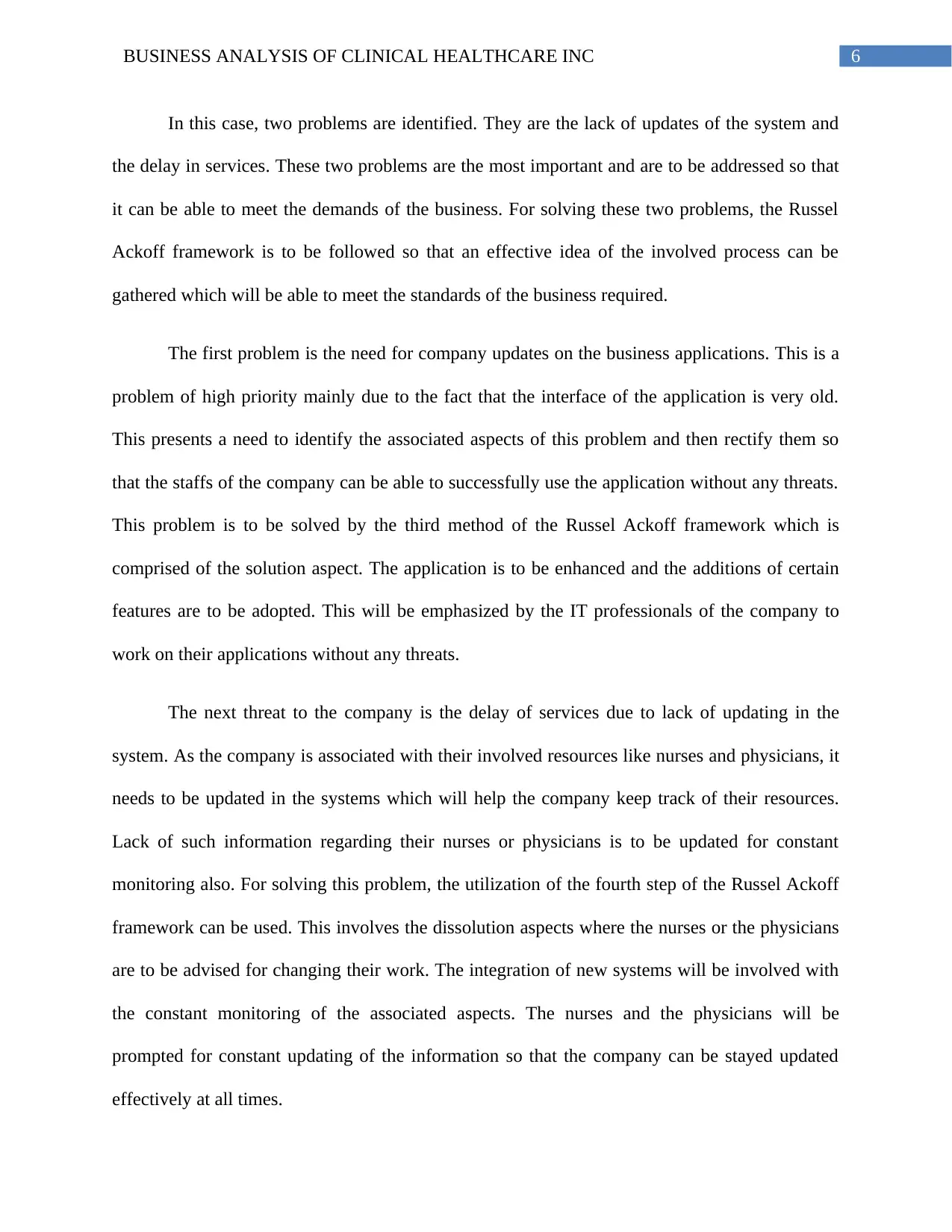
6BUSINESS ANALYSIS OF CLINICAL HEALTHCARE INC
In this case, two problems are identified. They are the lack of updates of the system and
the delay in services. These two problems are the most important and are to be addressed so that
it can be able to meet the demands of the business. For solving these two problems, the Russel
Ackoff framework is to be followed so that an effective idea of the involved process can be
gathered which will be able to meet the standards of the business required.
The first problem is the need for company updates on the business applications. This is a
problem of high priority mainly due to the fact that the interface of the application is very old.
This presents a need to identify the associated aspects of this problem and then rectify them so
that the staffs of the company can be able to successfully use the application without any threats.
This problem is to be solved by the third method of the Russel Ackoff framework which is
comprised of the solution aspect. The application is to be enhanced and the additions of certain
features are to be adopted. This will be emphasized by the IT professionals of the company to
work on their applications without any threats.
The next threat to the company is the delay of services due to lack of updating in the
system. As the company is associated with their involved resources like nurses and physicians, it
needs to be updated in the systems which will help the company keep track of their resources.
Lack of such information regarding their nurses or physicians is to be updated for constant
monitoring also. For solving this problem, the utilization of the fourth step of the Russel Ackoff
framework can be used. This involves the dissolution aspects where the nurses or the physicians
are to be advised for changing their work. The integration of new systems will be involved with
the constant monitoring of the associated aspects. The nurses and the physicians will be
prompted for constant updating of the information so that the company can be stayed updated
effectively at all times.
In this case, two problems are identified. They are the lack of updates of the system and
the delay in services. These two problems are the most important and are to be addressed so that
it can be able to meet the demands of the business. For solving these two problems, the Russel
Ackoff framework is to be followed so that an effective idea of the involved process can be
gathered which will be able to meet the standards of the business required.
The first problem is the need for company updates on the business applications. This is a
problem of high priority mainly due to the fact that the interface of the application is very old.
This presents a need to identify the associated aspects of this problem and then rectify them so
that the staffs of the company can be able to successfully use the application without any threats.
This problem is to be solved by the third method of the Russel Ackoff framework which is
comprised of the solution aspect. The application is to be enhanced and the additions of certain
features are to be adopted. This will be emphasized by the IT professionals of the company to
work on their applications without any threats.
The next threat to the company is the delay of services due to lack of updating in the
system. As the company is associated with their involved resources like nurses and physicians, it
needs to be updated in the systems which will help the company keep track of their resources.
Lack of such information regarding their nurses or physicians is to be updated for constant
monitoring also. For solving this problem, the utilization of the fourth step of the Russel Ackoff
framework can be used. This involves the dissolution aspects where the nurses or the physicians
are to be advised for changing their work. The integration of new systems will be involved with
the constant monitoring of the associated aspects. The nurses and the physicians will be
prompted for constant updating of the information so that the company can be stayed updated
effectively at all times.
Paraphrase This Document
Need a fresh take? Get an instant paraphrase of this document with our AI Paraphraser
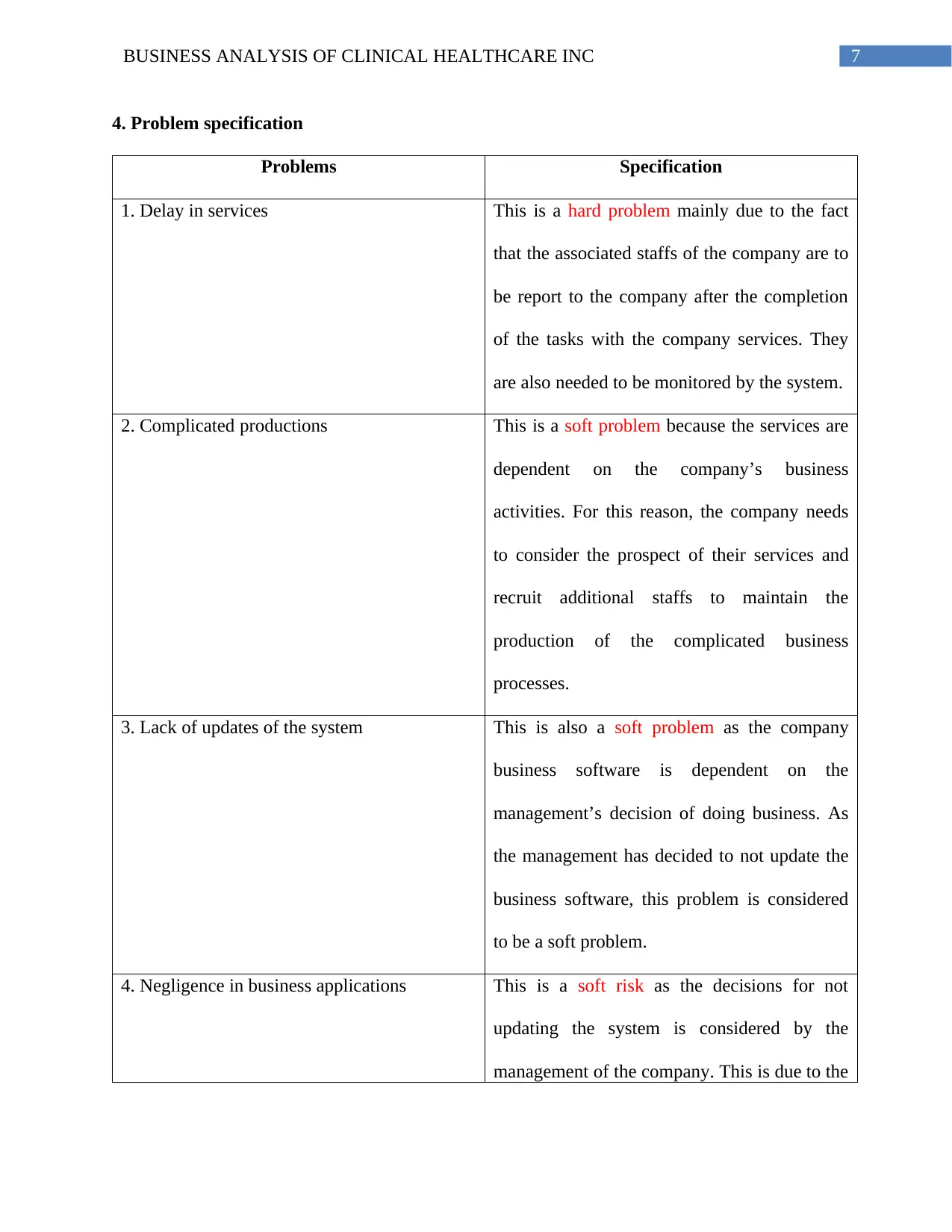
7BUSINESS ANALYSIS OF CLINICAL HEALTHCARE INC
4. Problem specification
Problems Specification
1. Delay in services This is a hard problem mainly due to the fact
that the associated staffs of the company are to
be report to the company after the completion
of the tasks with the company services. They
are also needed to be monitored by the system.
2. Complicated productions This is a soft problem because the services are
dependent on the company’s business
activities. For this reason, the company needs
to consider the prospect of their services and
recruit additional staffs to maintain the
production of the complicated business
processes.
3. Lack of updates of the system This is also a soft problem as the company
business software is dependent on the
management’s decision of doing business. As
the management has decided to not update the
business software, this problem is considered
to be a soft problem.
4. Negligence in business applications This is a soft risk as the decisions for not
updating the system is considered by the
management of the company. This is due to the
4. Problem specification
Problems Specification
1. Delay in services This is a hard problem mainly due to the fact
that the associated staffs of the company are to
be report to the company after the completion
of the tasks with the company services. They
are also needed to be monitored by the system.
2. Complicated productions This is a soft problem because the services are
dependent on the company’s business
activities. For this reason, the company needs
to consider the prospect of their services and
recruit additional staffs to maintain the
production of the complicated business
processes.
3. Lack of updates of the system This is also a soft problem as the company
business software is dependent on the
management’s decision of doing business. As
the management has decided to not update the
business software, this problem is considered
to be a soft problem.
4. Negligence in business applications This is a soft risk as the decisions for not
updating the system is considered by the
management of the company. This is due to the
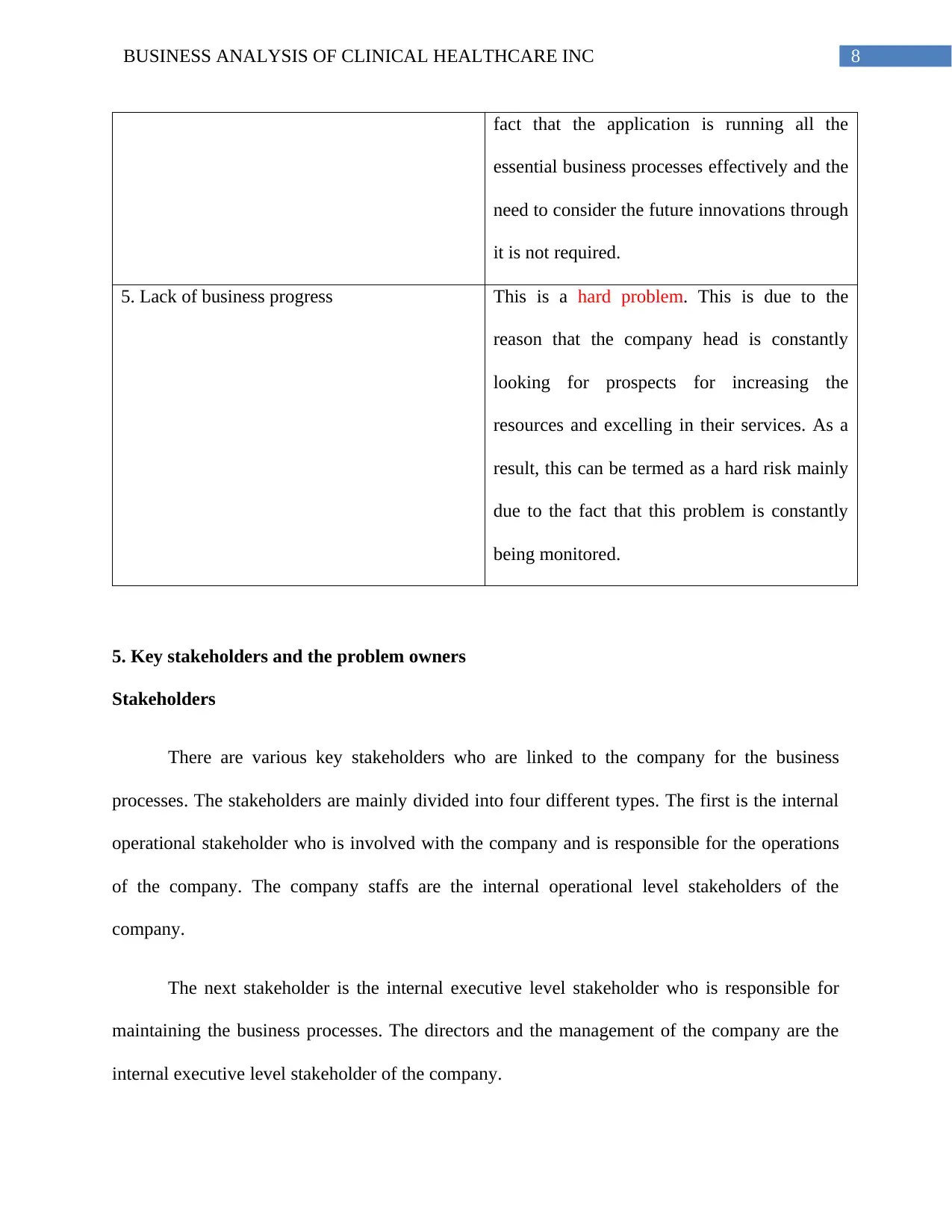
8BUSINESS ANALYSIS OF CLINICAL HEALTHCARE INC
fact that the application is running all the
essential business processes effectively and the
need to consider the future innovations through
it is not required.
5. Lack of business progress This is a hard problem. This is due to the
reason that the company head is constantly
looking for prospects for increasing the
resources and excelling in their services. As a
result, this can be termed as a hard risk mainly
due to the fact that this problem is constantly
being monitored.
5. Key stakeholders and the problem owners
Stakeholders
There are various key stakeholders who are linked to the company for the business
processes. The stakeholders are mainly divided into four different types. The first is the internal
operational stakeholder who is involved with the company and is responsible for the operations
of the company. The company staffs are the internal operational level stakeholders of the
company.
The next stakeholder is the internal executive level stakeholder who is responsible for
maintaining the business processes. The directors and the management of the company are the
internal executive level stakeholder of the company.
fact that the application is running all the
essential business processes effectively and the
need to consider the future innovations through
it is not required.
5. Lack of business progress This is a hard problem. This is due to the
reason that the company head is constantly
looking for prospects for increasing the
resources and excelling in their services. As a
result, this can be termed as a hard risk mainly
due to the fact that this problem is constantly
being monitored.
5. Key stakeholders and the problem owners
Stakeholders
There are various key stakeholders who are linked to the company for the business
processes. The stakeholders are mainly divided into four different types. The first is the internal
operational stakeholder who is involved with the company and is responsible for the operations
of the company. The company staffs are the internal operational level stakeholders of the
company.
The next stakeholder is the internal executive level stakeholder who is responsible for
maintaining the business processes. The directors and the management of the company are the
internal executive level stakeholder of the company.
⊘ This is a preview!⊘
Do you want full access?
Subscribe today to unlock all pages.

Trusted by 1+ million students worldwide
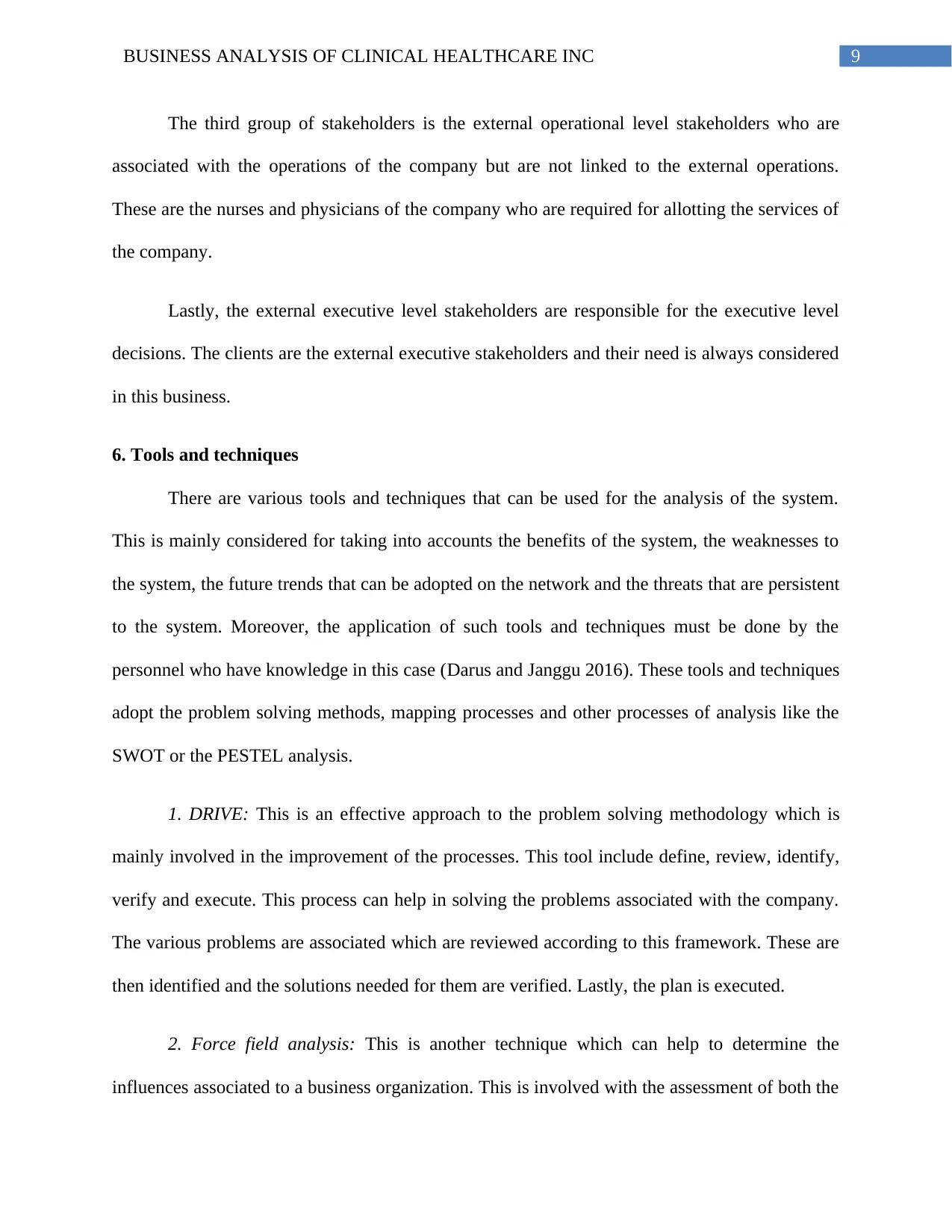
9BUSINESS ANALYSIS OF CLINICAL HEALTHCARE INC
The third group of stakeholders is the external operational level stakeholders who are
associated with the operations of the company but are not linked to the external operations.
These are the nurses and physicians of the company who are required for allotting the services of
the company.
Lastly, the external executive level stakeholders are responsible for the executive level
decisions. The clients are the external executive stakeholders and their need is always considered
in this business.
6. Tools and techniques
There are various tools and techniques that can be used for the analysis of the system.
This is mainly considered for taking into accounts the benefits of the system, the weaknesses to
the system, the future trends that can be adopted on the network and the threats that are persistent
to the system. Moreover, the application of such tools and techniques must be done by the
personnel who have knowledge in this case (Darus and Janggu 2016). These tools and techniques
adopt the problem solving methods, mapping processes and other processes of analysis like the
SWOT or the PESTEL analysis.
1. DRIVE: This is an effective approach to the problem solving methodology which is
mainly involved in the improvement of the processes. This tool include define, review, identify,
verify and execute. This process can help in solving the problems associated with the company.
The various problems are associated which are reviewed according to this framework. These are
then identified and the solutions needed for them are verified. Lastly, the plan is executed.
2. Force field analysis: This is another technique which can help to determine the
influences associated to a business organization. This is involved with the assessment of both the
The third group of stakeholders is the external operational level stakeholders who are
associated with the operations of the company but are not linked to the external operations.
These are the nurses and physicians of the company who are required for allotting the services of
the company.
Lastly, the external executive level stakeholders are responsible for the executive level
decisions. The clients are the external executive stakeholders and their need is always considered
in this business.
6. Tools and techniques
There are various tools and techniques that can be used for the analysis of the system.
This is mainly considered for taking into accounts the benefits of the system, the weaknesses to
the system, the future trends that can be adopted on the network and the threats that are persistent
to the system. Moreover, the application of such tools and techniques must be done by the
personnel who have knowledge in this case (Darus and Janggu 2016). These tools and techniques
adopt the problem solving methods, mapping processes and other processes of analysis like the
SWOT or the PESTEL analysis.
1. DRIVE: This is an effective approach to the problem solving methodology which is
mainly involved in the improvement of the processes. This tool include define, review, identify,
verify and execute. This process can help in solving the problems associated with the company.
The various problems are associated which are reviewed according to this framework. These are
then identified and the solutions needed for them are verified. Lastly, the plan is executed.
2. Force field analysis: This is another technique which can help to determine the
influences associated to a business organization. This is involved with the assessment of both the
Paraphrase This Document
Need a fresh take? Get an instant paraphrase of this document with our AI Paraphraser
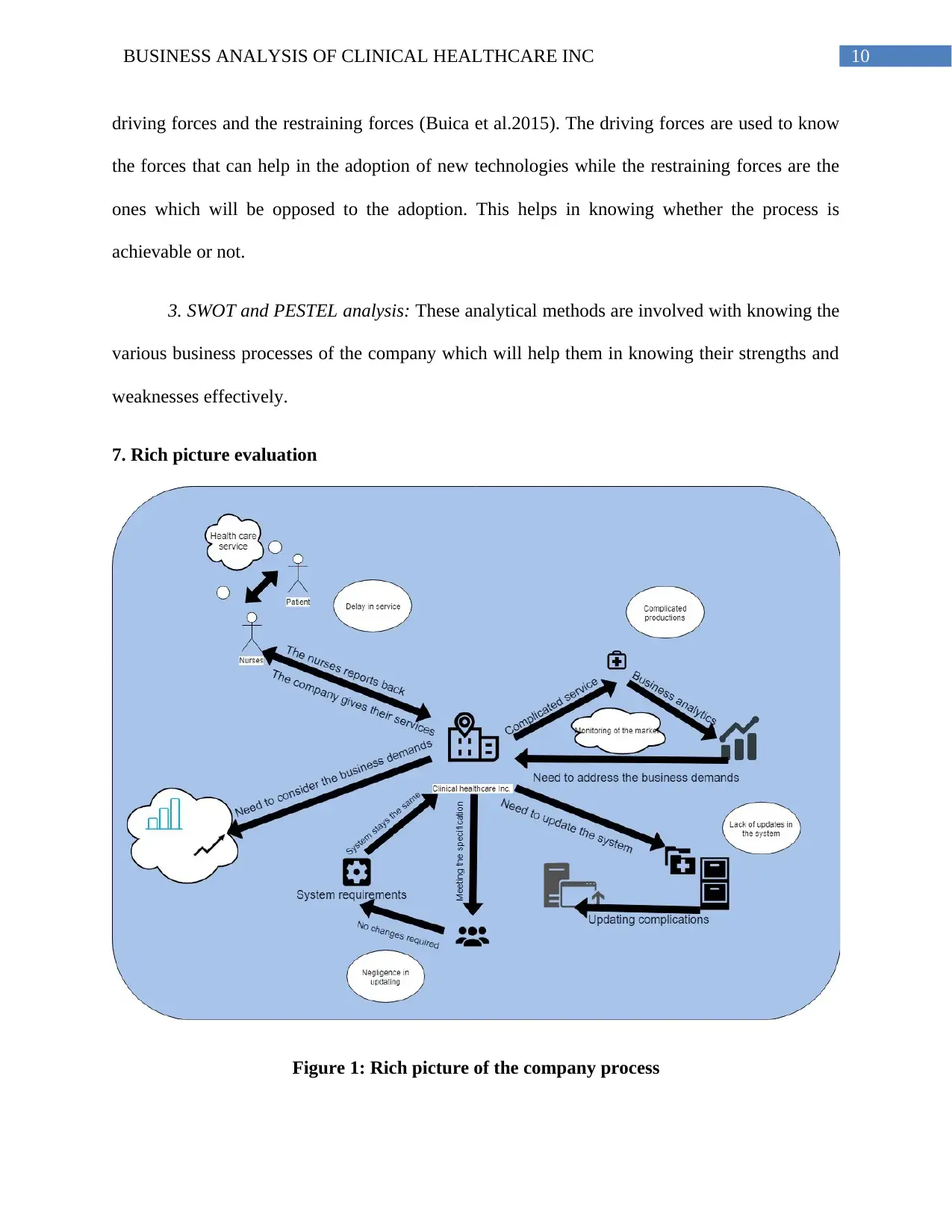
10BUSINESS ANALYSIS OF CLINICAL HEALTHCARE INC
driving forces and the restraining forces (Buica et al.2015). The driving forces are used to know
the forces that can help in the adoption of new technologies while the restraining forces are the
ones which will be opposed to the adoption. This helps in knowing whether the process is
achievable or not.
3. SWOT and PESTEL analysis: These analytical methods are involved with knowing the
various business processes of the company which will help them in knowing their strengths and
weaknesses effectively.
7. Rich picture evaluation
Figure 1: Rich picture of the company process
driving forces and the restraining forces (Buica et al.2015). The driving forces are used to know
the forces that can help in the adoption of new technologies while the restraining forces are the
ones which will be opposed to the adoption. This helps in knowing whether the process is
achievable or not.
3. SWOT and PESTEL analysis: These analytical methods are involved with knowing the
various business processes of the company which will help them in knowing their strengths and
weaknesses effectively.
7. Rich picture evaluation
Figure 1: Rich picture of the company process
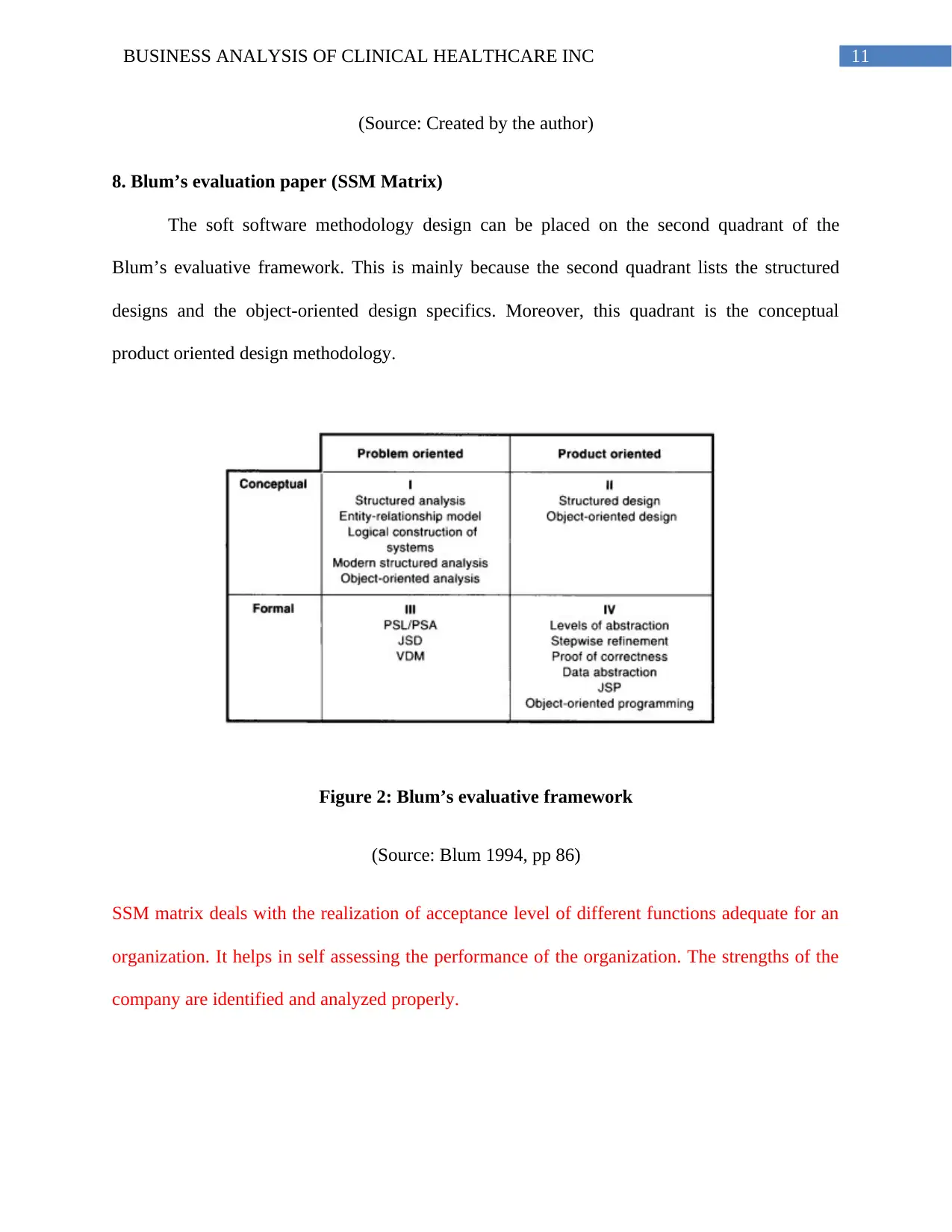
11BUSINESS ANALYSIS OF CLINICAL HEALTHCARE INC
(Source: Created by the author)
8. Blum’s evaluation paper (SSM Matrix)
The soft software methodology design can be placed on the second quadrant of the
Blum’s evaluative framework. This is mainly because the second quadrant lists the structured
designs and the object-oriented design specifics. Moreover, this quadrant is the conceptual
product oriented design methodology.
Figure 2: Blum’s evaluative framework
(Source: Blum 1994, pp 86)
SSM matrix deals with the realization of acceptance level of different functions adequate for an
organization. It helps in self assessing the performance of the organization. The strengths of the
company are identified and analyzed properly.
(Source: Created by the author)
8. Blum’s evaluation paper (SSM Matrix)
The soft software methodology design can be placed on the second quadrant of the
Blum’s evaluative framework. This is mainly because the second quadrant lists the structured
designs and the object-oriented design specifics. Moreover, this quadrant is the conceptual
product oriented design methodology.
Figure 2: Blum’s evaluative framework
(Source: Blum 1994, pp 86)
SSM matrix deals with the realization of acceptance level of different functions adequate for an
organization. It helps in self assessing the performance of the organization. The strengths of the
company are identified and analyzed properly.
⊘ This is a preview!⊘
Do you want full access?
Subscribe today to unlock all pages.

Trusted by 1+ million students worldwide
1 out of 15
Related Documents
Your All-in-One AI-Powered Toolkit for Academic Success.
+13062052269
info@desklib.com
Available 24*7 on WhatsApp / Email
![[object Object]](/_next/static/media/star-bottom.7253800d.svg)
Unlock your academic potential
Copyright © 2020–2025 A2Z Services. All Rights Reserved. Developed and managed by ZUCOL.





